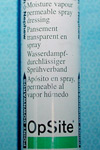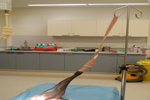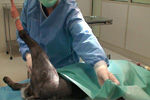The Patient
Unit 5: Preparation for Surgery
Topic 3: Patient Draping
Draping isolates the surgical site from contamination from non-sterile areas including the surrounding hair and skin. The drapes should ideally cover the entire patient and table.
It is important that they remain securely fastened to the patient during the procedure, usually by an adhesive strip along the edge of each utility (rectangular) drape or by clamping (using a towel clip) in each corner of the utility drape. Skin clamps are only used for linen drapes not disposable drapes.
A second larger drape (fenestrated)is then placed over the top to form a second layer.
The following demonstration utilising linen drapes follows a placement pattern of top, tail, near and far. The reason for this, is that in deep chested dogs, holding a lateral drape in place is difficult because a second drape has to be applied before it can be secured by a towel clamp.
When utilising single-use (disposable) drapes, these should have adhesive strips, to adhere to the patients skin and don't "fall off" therefore the placement pattern is near, top, tail and far.
 |

click to download Surgical Operational Procedure on Draping - pdf (495Kb)
Both reusable (linen) and disposable (single-use) drapes are available.
Materials used for draping have traditionally been woven fabric, which provides an effective barrier when dry, however in the presence of moisture, the protective barrier effect is completely lost. Bacteria can pass from the patient’s skin surface, through the wet woven drapes and onto the surgical field, thus contaminating the patient's sterile tissue.
Single-use disposable drapes are the preferred option for invasive procedures in veterinary surgery.
Adhesive incise drapes (eg. Opsite) are also available and can be applied to the isolated area to create a barrier between the incision and the surrounding prepared (but not sterile!) skin. They are waterproof and the incision can be made directly through the drape.
Adhesive incise drapes can be made to stick better to canine and feline skin by initially spraying the prepared surgical site with a liquid preparation (Opsite®), which fills the unevenness. Wait for the spray to dry before applying the adhesive incise drape.
Significant reductions in the numbers of bacteria in surgical wounds have been documented using disposable (single-use) and opsite drapes. When one considers the initial cost and labour intensity of producing re-usable drapes, the cost of disposable gowns and drapes, with the guarantee of sterility is a preferable option.
For minor procedures such as small skin “lumpectomies”, a small fenestrated drape is often adequate.
For many orthopaedic procedures on the limbs a "free-draping" technique may be used to help surgical manipulation of the limb. To isolate the limb, the limb is suspended using a drip stand with the foot enclosed inside a clean latex glove. The glove is secured to the foot with adhesive tape.
The limb is then clipped and prepared as previously described, and a triangle of drapes are placed around the base of the limb to isolate it from the trunk. The distal limb and foot can be isolated with another sterile drape, orthopaedic stockinette or bandage, and released from the drip stand.
A DVD on Draping technique can be found on the LMS or in the Clinical Skills Centre




